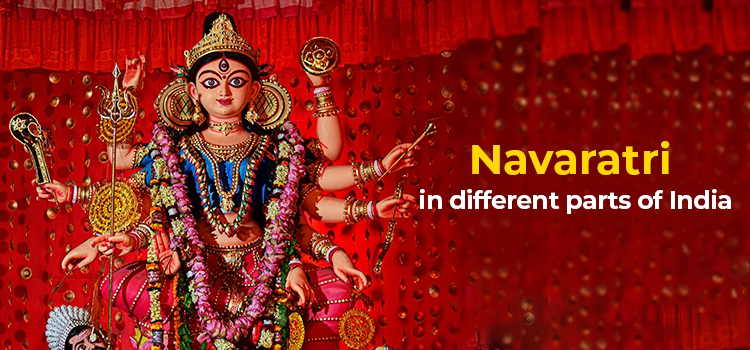Navratri in Different Parts of India
India is a country that has an amazing diversity of languages, food habits, religions, practices, cultures, attires, etc. The curious thing is that there is diversity within diversity. For example, different states celebrate the same festival in different ways. The way people worship changes according to their region’s or community’s customs and rituals. The message is the same, but the communication style has a different flavor.
Navratri is an excellent example of such diversity. Navratri means ‘nine nights.’ It is a festival that honors the Supreme Goddess or Shakti. For 9 nights, Hindus worship 9 different forms of the Mother Goddess. Let us see how different regions of India celebrate this colorful and fascinating festival.

Navaratri in North India
In North India, the Navratri festival celebrates the victory of Lord Rama over the demon king, Ravana. It culminates in the Ramlila performance, which is enacted on Dussehra, the 10th day. Devotees burn effigies of Ravana and his brother, Kumbhakarna, to celebrate the victory of good (Rama) over evil on 'Vijaya Dashami' day.
On all 9 Navratri days, there are special Navratri Poojas, yagnas, homas, etc. People also observe fasts, meditate, maintain silence, sing and dance to honor the Goddess.
North Indians have the custom of giving gifts on Navratri. They include sweets, clothes, and household items. Kanya Pooja takes place on the 8th and 9th days. Young girls below the age of 10 are invited home and revered like a Goddess. At the end of the ceremony, they get gifts like money and sweets.
Navratri in Western India
In Western India, especially Gujarat, Navratri features dances like Garba and Dandiya-Raas. In Garba, women dance gracefully, moving in circles around a pot in which there is a lighted lamp. ‘Garba’ means ‘womb’. The lamp inside the pot represents life within the womb. In Dandiya Raas, men and women dance in pairs with dandiyas or small, decorated bamboo sticks in their hands. Tiny bells at the end of the dandiyas make a jingling sound when the sticks clash against each other. It is a dance with a complex rhythm. The tempo is slow at first, but soon the movements become frenzied. Men, women, and children play the garba for ten days, from nine in the evening to four in the morning, daily. Each city in Gujarat has its own style of garba."
Societies and clubs in the state organize such garbas. People conduct Garba classes in every city and town. The women buy new chaniya-cholis the men buy new turbans and kedias for the occasion. Even those who fast attend the garba each evening.
Navratri in Eastern India
In West Bengal and the North-eastern states, the last 5 days of Sharad Navratri are celebrated as Durga Pooja. It commemorates the slaying of Mahishasura by Goddess Durga. Durga holds many weapons in her hand and rides a lion. The lion signifies dharma or willpower, while the weapons represent the severity required to destroy the negativity in our minds. The 8th day is Durgashtami. Life-size clay idols of Durga, exquisitely crafted and decorated, are installed in temples and other places. Devotees worship these idols for five days and immerse them in the river on the last day.
People also go pandal hopping by visiting Durga Pooja pandals. Each has a different theme and vibe. Some pandals may have great lighting and sound, while others are more simple. Women dresss to the nines in their gorgeous Bengali saris, while the men dress up in kurta-pyjamas. But the best part is attending the Maha Aarti in the evenings.
Navaratri in Southern India
In south India, Navratri is the time for Golu. Friends, relatives, and neighbors are invited home to look at the Golu, a display of various dolls and figurines. In Kannada, this is called Bombe Habba, in Tamil, Bommai Golu, and in Telugu, Bommala Koluvu.
Navratri is Dasara in Karnataka. Yakshagana (a dance in the form of epic dramas from the Puranas) is performed during the nine nights of the Navratri festival. Mysore Dasara festival is celebrated grandly as it is also the state festival. The royal family of Mysore and their jumbo savari or elephant parade is the highlight of the celebrations.
Ayudha Pooja ritual takes place on Mahanavami (9th day). Tools, agricultural implements, books, musical instruments, machinery, equipment, and automobiles are decorated and worshipped on this day to honor Goddess Saraswati.
The 10th day is 'Vijaya Dashami'. It marks “Vidyaarambam” in Kerala, when young children are initiated into the world of letters. In Mysore, on Dussehra, there are grand processions carrying Goddess Chamundi on the streets.
Many devotees observe Navratri fast and meditate on all nine days of Navratri. It is a time to rest, rejuvenate and reflect on our spiritual progress.
Why is Navratri Celebrated?
Navratri celebrates Durga’s victory over Mahishasura, the buffalo demon. Like Vishnu’s incarnations, Durga, too, is an avatar of the Divine Mother to preserve order and righteousness in the Universe. The demon is a symbol of all the evil that lurks within us, like anger, hatred, ego, envy, jealousy, greed, lust, etc. Our salvation, as in the case of Mahisha, lies in surrendering to the Goddess.
Navratri 2022 date: Sept 26 – Oct 4.



















